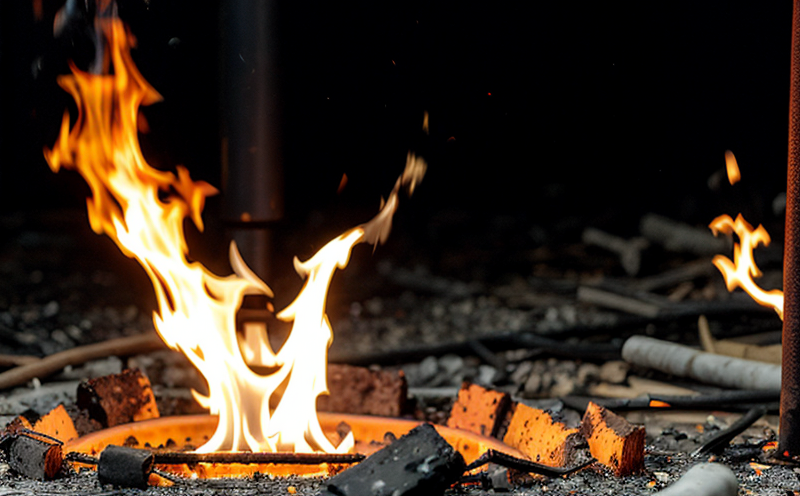Flammability Testing
In the realm of toy testing, ensuring safety and compliance with international standards is paramount. Flammability testing plays a crucial role in safeguarding children from potential hazards by preventing materials that could easily catch fire. This testing ensures toys are constructed with non-flammable or flame-retardant components to meet rigorous global safety regulations.
The primary objective of flammability testing is to assess the likelihood of ignition and the rate at which a toy can spread flames if exposed to an external source, such as a lighter or match. This assessment is critical in sectors where children interact closely with products, minimizing risks associated with accidental fires.
Flammability tests follow international standards like ISO 13917-2 for textiles and plastics used in toys. The test involves placing the toy specimen in a specially designed chamber, exposing it to a flame source, and measuring parameters such as time to ignition, duration of flaming, and residual char length after extinguishment.
Compliance officers must understand that flammability testing is not just about meeting regulatory requirements but also about protecting children. The use of advanced instruments like cone calorimeters ensures accurate readings that can predict real-world scenarios accurately. This data helps in refining product designs to ensure they are safe and meet stringent safety criteria.
Quality managers need to be aware of the importance of pre-test specimen preparation, which includes cleaning, conditioning, and cutting specimens to standard dimensions. Rigorous quality control measures during testing ensure that results are reliable and repeatable. This process is essential for maintaining product consistency across different batches and production runs.
Scope and Methodology
The scope of flammability testing in toy manufacturing is extensive, covering various materials used in toys such as fabrics, plastics, foam, and even certain paints. The methodology involves a series of standardized tests designed to evaluate the flammability characteristics of these materials.
- Test Methods: Cone calorimeter test (ISO 13917-2), horizontal burn rate test (ASTM F1958).
- Parameters Measured: Time to ignition, maximum heat release rate, smoke production.
The testing process begins with selecting representative samples of the toy materials. These samples are then prepared according to specified dimensions and conditions. The specimens are placed in a controlled environment where they are exposed to a flame source for a set duration. The behavior of the material under these conditions is recorded, providing insights into its flammability characteristics.
For compliance officers, understanding the test methods ensures adherence to industry standards. For R&D engineers, this knowledge aids in developing safer toy designs that can withstand real-world scenarios without posing risks. The results from these tests are crucial for making informed decisions about material selection and design improvements.
Quality and Reliability Assurance
The quality and reliability of flammability testing in the toy industry are critical to ensuring product safety. To maintain high standards, laboratories employ stringent quality control measures at every stage of the testing process.
- Calibration: Instruments like calorimeters must be regularly calibrated against known reference materials.
- Data Validation: Multiple tests are conducted on each specimen to ensure consistent results.
- Material Handling: Specimens are handled with care to prevent contamination or damage that could affect test outcomes.
The reliability of the testing process is further enhanced through rigorous training and certification of laboratory personnel. Only certified professionals operate the equipment, ensuring accurate data collection and interpretation. Regular audits by independent bodies ensure continuous adherence to quality standards.
For procurement teams, understanding these quality assurance measures ensures that they select reliable suppliers who adhere to strict testing protocols. This collaboration between manufacturers and suppliers helps in maintaining high-quality products that meet all safety requirements.
Use Cases and Application Examples
The application of flammability testing is crucial across various sectors, particularly in the toy industry. Here are some real-world use cases:
- Design Validation: Before a new toy design enters production, it undergoes flammability tests to ensure compliance with safety standards.
- Material Selection: Manufacturers use test results to select non-flammable materials for their products.
- Production Monitoring: During mass production, periodic testing ensures that all batches meet the required safety criteria.
An example of a successful application is the development of a new soft toy. Before release, this toy undergoes flammability tests to ensure it meets ISO 13917-2 standards. The results are documented and shared with regulatory bodies to gain approval for market entry.
For R&D engineers, these tests provide valuable insights into material behavior under fire conditions. They can use the data to refine designs and improve product safety. Compliance officers can leverage this information to ensure all products comply with international standards, thereby protecting public health and safety.





